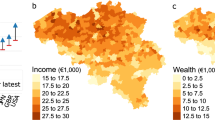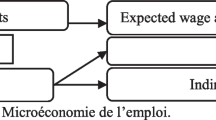Abstract
Although the debate about the effect of wealth on entrepreneurship or self-employment is now almost two decades old, there is little consensus among researchers about the significance of wealth as a determinant for self-employment. In this paper, we shift the focus from whether potential entrepreneurs, as a group, are credit constrained, to whom among potential entrepreneurs is credit constrained. We consider the impact of education and experience on the probability of choosing self-employment, in an environment where individuals may be credit constrained. We find that for individuals with low human capital, wealth and entrepreneurial entry are negatively related, while wealth has no statistically significant effect on entry for individuals with medium to high human capital. This result is puzzlingly at odds with the classic Evans-Jovanovic model for entrepreneurial entry. We discuss one possibility for reconciling the two.







Similar content being viewed by others
Notes
Early research on this topic has consistently suggested that individuals face binding liquidity constraints in entrepreneurial choice decisions [Evans and Jovanovic, 1989; Holtz-Eakin et al. 1994; Blanchflower and Oswald 1998; Quadrini 1999]. This view has recently been challenged by Hurst and Lusardi [2004] who argued that liquidity constraints are not binding for aspiring entrepreneurs over a majority of the wealth distribution. Their evidence has generated renewed interest in the question of liquidity constraints and entrepreneurship, and it has been countered by empirical [Fairlie and Krashinsky 2006] and theoretical work [Cagetti and De Nardi 2006].
Some of the prominent papers in this line of research are listed in Footnote 1.
We expect the transition to self-employment to be distinct for unemployed individuals, in terms of the factors and motivations affecting their labor market decisions.
Net worth will be used interchangeably with wealth in our discussion below.
Individuals at or below the 50th percentile have less than 6 months of work experience.
The partial F-statistic (like partial R2) provides us with a test of the relevance of our instruments. We find a partial F-statistic of 12.17 when we regress net worth on our instrument, as well as all the exogenous variables in our sample and test the null of whether the coefficient on our instrument is zero. According to the cutoff of 10 provided in Staiger and Stock [1997], housing price residuals satisfy the relevance requirement for the full sample.
We do not have complete information on the market value of each individual's house for two different years over which to calculate the change in home value, so the number of observations in our IV regressions is significantly lower than for our regular probit regressions.
References
Astbro, T., and I. Bernhardt . 2005. The Winner's Curse of Human Capital. Small Business Economics, 24 (1): 63–78.
Bernhardt, D. 2000. Credit Rationing? American Economic Review, 90 (1): 235–239.
Blanchflower, D., and A. Oswald . 1998. What Makes an Entrepreneur? Journal of Labor Economics, 16 (1): 26–60.
Cagetti, M., and M. De Nardi . 2006. Entrepreneurship, Frictions and Wealth. Journal of Political Economy, 114 (5): 835–870.
Disney, R., and J. Gathergood . 2009. Housing Wealth, Liquidity Constraints, and Self-employment. Labour Economics, 16 (1): 79–88.
Dunn, T., and D. Holtz-Eakin . 2000. Financial Capital, Human Capital, and the Transition to Self-Employment: Evidence from Intergenerational Links. Journal of Labor Economics, 18 (2): 282–305.
Evans, D., and B. Jovanovic . 1989. An Estimated Model of Entrepreneurial Choice Under Liquidity Constraints. Journal of Political Economy, 97 (4): 808–826.
Evans, D., and L. Leighton . 1989. Some Empirical Aspects of Entrepreneurship. American Economic Review, 79 (3): 519–535.
Fairlie, R . 1999. The Absence of the African-American Owned Business: An Analysis of the Dynamics of Self-employment. Journal of Labor Economics, 17 (1): 80–108.
Fairlie, R . 2004. Self-employed Business Ownership Rates in the United States: 1979–2003, Small Business Research Summary, SBA No. 243 (December).
Fairlie, R., and H. Krashinsky . 2006. Liquidity Constraints, Household Wealth and Entrepreneurship Revisited, IZA Discussion Papers no. 2201.
Gentry, W., and R. Hubbard . 2004. Entrepreneurship and Household Saving. Advances in Economic Analysis and Policy, 4 (1): 1–55.
Holtz-Eakin, D., D. Joulaian, and H. Rosen . 1994. Sticking it Out: Entrepreneurial Survival and Liquidity Constraints. Journal of Political Economy, 102 (1): 53–75.
Hurst, E., and A. Lusardi . 2004. Liquidity Constraints, Household Wealth and Entrepreneurship. Journal of Political Economy, 112 (2): 319–347.
Nanda, R., and W. Kerr . 2009. Financing Constraints and Entrepreneurship, NBER Working Paper 15498.
Parker, S., and C.M. van Praag . 2006. The Entrepreneur's Mode of Entry: Business Takeover or New Business Start? IZA Discussion Papers no. 2382.
Parker, S. 2006. The Economics of Self-Employment and Entrepreneurship. Cambridge Books: Cambridge University Press.
Parker, S. . 2008. Entrepreneurship Among Married Couples in the United States: A Simultaneous Probit Approach. Labour Economics, 15 (3): 459–481.
Quadrini, V. 1999. The Importance of Entrepreneurship for Wealth Concentration and Mobility. Review of Income and Wealth, 45 (1): 1–19.
Staiger, D., and J.H. Stock . 1997. Instrumental Variables Regression With Weak Instruments. Econometrica, 65 (3): 557–586.
Acknowledgements
We are grateful to Christopher Carroll, Thomas Lubik, Bart Moore, and seminar participants at the Eastern Economic Association Meetings for helpful comments. Berna Demiralp acknowledges the financial support of the Office of Research, Old Dominion University, through its Summer Research Fellowship Program.
Author information
Authors and Affiliations
Rights and permissions
About this article
Cite this article
Demiralp, B., Francis, J. Wealth, Human Capital and the Transition to Self-Employment. Eastern Econ J 39, 72–92 (2013). https://doi.org/10.1057/eej.2012.5
Published:
Issue Date:
DOI: https://doi.org/10.1057/eej.2012.5




